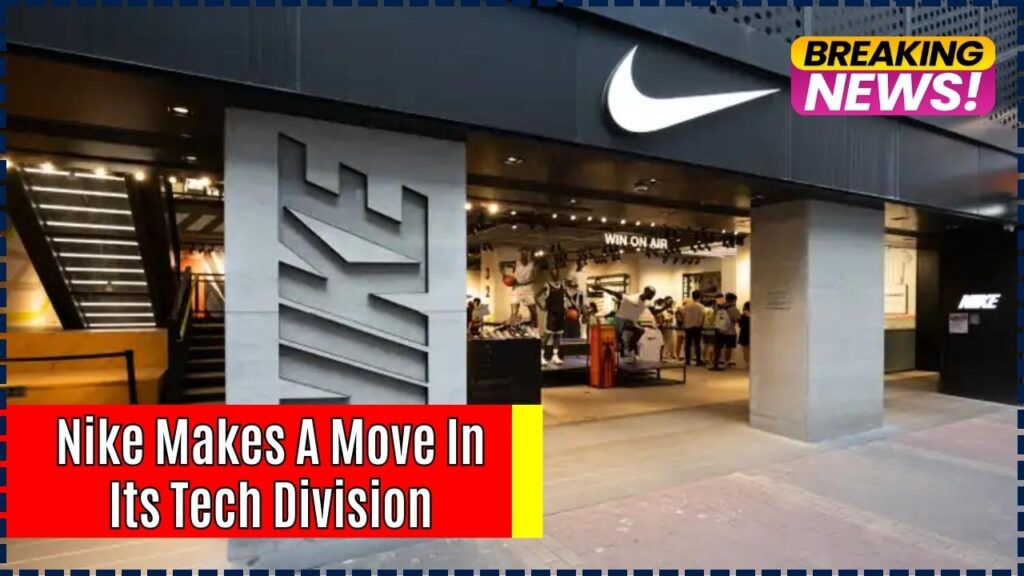Nike Makes A Move In Its Tech Division: In a bold and revealing strategic pivot, Nike makes a move in its tech division, triggering widespread interest and speculation across the global retail, fashion, and technology sectors. This behind-the-scenes shake-up involves a combination of employee layoffs and an aggressive effort to outsource core technology functions to third-party vendors. While this decision may seem abrupt, it’s actually part of a meticulously planned campaign to streamline operations, drive innovation, and enhance Nike’s long-term competitiveness in an increasingly tech-driven marketplace.

The move comes during a complex period for Nike. Despite maintaining strong brand equity and loyal global customers, the sportswear giant reported a significant 9% decline in third-quarter sales for fiscal 2025. Such a drop has prompted senior leadership to scrutinize every department—especially technology—to determine how best to reposition the company for future growth. In today’s business climate, tech is no longer a support function; it is a strategic pillar. Nike’s recent actions reflect this new reality.
Nike Makes A Move In Its Tech Division
| Topic | Details |
|---|---|
| Event | Nike restructures its technology division |
| Actions Taken | Employee layoffs, increased outsourcing |
| Stated Goal | Streamline tech operations, focus on innovation |
| Sales Decline | 9% drop in Q3 FY2025 |
| Primary Impacts | Digital ecosystem control, cost optimization |
| CEO | Elliott Hill |
| Affected Areas | Internal software engineering, cloud infrastructure |
| Future Strategy | Emphasize wearable tech, AI, and hybrid retail experiences |
| Source | Nike Official Site |
Nike’s strategic overhaul of its tech division is more than a cost-cutting move—it’s a declaration of intent to lead in the next wave of digital innovation. As the company realigns its resources, it is positioning itself to drive meaningful advances in smart wearables, AI-driven personalization, and omnichannel retail. The challenge will be managing this transition without losing control of its digital identity.
For professionals, Nike’s story underscores the importance of adaptability, technical fluency, and strategic thinking in today’s fast-evolving work environment. Whether you’re a tech vendor, a brand strategist, or a recent grad, the lessons from this case are invaluable.
Understanding Nike’s Technology Transformation
Technology is not just an enabler at Nike—it’s central to the brand’s identity. Over the past decade, Nike has introduced an array of innovations designed to integrate the digital and physical worlds. From smart sneakers embedded with sensors to Nike Run Club and Nike Training Club, the company has crafted one of the most robust digital ecosystems in the athletic wear market. However, innovation doesn’t come without risk. Maintaining an expansive internal tech workforce has proven both expensive and unwieldy.
Nike has realized that, in order to remain agile and consumer-focused, it needs to lean into its core strengths: product innovation, branding, and direct-to-consumer engagement. This means letting go of certain backend tech responsibilities, especially those that third-party partners can manage more efficiently.
Why the Change Now?
This transformation didn’t emerge from a vacuum. There are multiple factors contributing to Nike’s pivot:
- Hybrid fitness boom: With consumers toggling between in-person and digital fitness experiences, companies must deliver seamless omnichannel solutions.
- Rising tech costs: Maintaining high-caliber in-house engineering teams is expensive and requires constant investment.
- Shifting consumer demands: Users want personalized experiences, fast delivery, and on-demand service—powered by tech.
- Increased global competition: Rivals like Adidas, Puma, and newer entrants like Gymshark are leveraging tech partnerships to scale faster.
As a result, Nike is shifting its internal focus from maintaining platforms to designing next-gen tech experiences that can differentiate the brand in a saturated market.
What Exactly Is Nike Makes A Move In Its Tech Division?
1. Layoffs in the Technology Division
As confirmed by Bloomberg, Nike has begun reducing headcount within its internal technology teams. While specific figures remain undisclosed, insiders report that roles related to cloud engineering, backend software development, and legacy IT infrastructure are most affected. The move signals a departure from the traditional full-stack in-house model to a leaner, partnership-driven approach.
“We are realigning our resources to drive deeper value and unlock growth through focused innovation,” stated a Nike executive.
2. Outsourcing of Core Functions
Nike has confirmed that various tech services—including cloud hosting, data analytics pipelines, and some mobile app development—will now be outsourced to industry-leading partners. These vendors are expected to bring faster turnaround times and specialized capabilities. However, outsourcing raises complex questions about data governance, compliance, and vendor lock-in. Nike will need robust oversight mechanisms to maintain system integrity and brand trust.
3. Focus on Core Product Innovation
Nike’s internal teams are being redirected toward high-impact innovation areas, including:
- Smart wearables and biometric sensors
- Sustainable materials tracking using blockchain
- AI and machine learning for personalized shopping
- AR/VR-enhanced retail experiences
These projects align tightly with Nike’s consumer-first philosophy and signal the brand’s commitment to not just keeping up, but leading in the tech-driven retail future.
Pros and Cons of Nike’s New Tech Strategy
Like any major strategic shift, Nike’s restructuring comes with benefits and potential pitfalls.
Pros:
- Lower Operational Costs: Reducing full-time staffing saves millions annually.
- Access to Expertise: Outsourcing gives Nike access to niche technical skills.
- Scalability: Vendors can ramp up support during seasonal peaks.
- Internal Focus: Frees up internal teams for forward-looking innovation.
Cons:
- Security and IP Concerns: Sharing sensitive tech with vendors increases risk.
- Vendor Dependency: Over-reliance can reduce internal control.
- Cultural Impact: Layoffs may harm morale and brand loyalty internally.
- Integration Complexity: Third-party platforms must be seamlessly aligned.
Ultimately, the success of this strategy will hinge on vendor selection, contract clarity, and agile management.
What This Means for Nike’s Future
This isn’t Nike’s first foray into digital transformation. In 2020, Nike acquired RTFKT, a trailblazing NFT and virtual apparel company. More recently, Nike explored digital twin technology to enhance online retail experiences. Despite these efforts, feedback from users has pointed to uneven app experiences and underwhelming smart tech integrations.
This latest move signals a more focused attempt to:
- Reduce internal friction
- Consolidate digital investments
- Build stronger, long-term strategic partnerships
By outsourcing tech operations while nurturing core innovations, Nike hopes to regain its status as a technology-forward brand. Analysts believe this hybrid approach could become a blueprint for other legacy brands looking to remain relevant in the age of digital-native competitors.
“Nike’s evolution from a shoe company to a tech-savvy lifestyle brand is entering a new phase. It’s all about agility now,” said a Technext24 analyst.
Expert Tips: How Tech Professionals Can Adapt
This shift has implications not only for Nike employees but for the broader tech and retail industries. Here’s how professionals can prepare:
1. Master Interdisciplinary Skills
Understand how tech drives business outcomes. Being fluent in both data science and customer experience (CX) makes you more competitive.
2. Embrace Flexibility
The age of permanent roles is fading. Prepare for project-based and freelance opportunities, especially with outsourcing partners.
3. Prioritize Certifications and Lifelong Learning
Upskill in emerging domains such as cloud security, DevOps, blockchain, and ethical AI.
4. Be Vendor-Savvy
Understanding vendor ecosystems, service-level agreements (SLAs), and integration protocols is now a key career advantage.
FAQs On Nike Makes A Move In Its Tech Division:
1. Why did Nike lay off technology employees?
Nike restructured its internal tech division to reduce operational costs and concentrate on innovation areas that align more directly with its brand vision.
2. What tech functions are being outsourced?
Cloud infrastructure, backend development, data engineering, and some aspects of mobile and web app maintenance are expected to be managed externally.
3. How will outsourcing affect Nike’s tech strategy?
Outsourcing allows Nike to stay nimble, leverage external expertise, and invest more heavily in customer-facing innovation projects.
4. Will this affect Nike’s digital products like apps and wearables?
Yes, but ideally for the better. With internal teams refocused, Nike aims to deliver higher-quality, more innovative consumer tech experiences.
5. How should tech workers adapt to trends like this?
Focus on hybrid skill sets, stay current with certifications, and consider consulting roles that support outsourced tech strategies.






